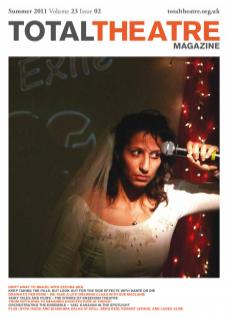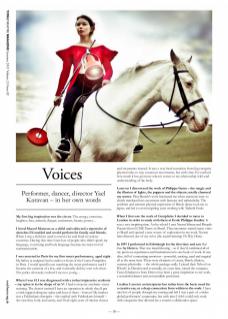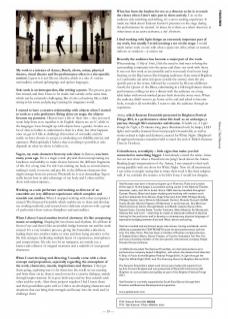My first big inspiration was the circus. The energy, emotions, laughter, fear, animals, danger, excitement, beauty, poetry…
I loved Marcel Marceau as a child and collected a repertoire of sketches I’d studied and would perform for family and friends. When I was a child we used to travel a lot and lived in various countries. During this time I met lots of people who didn’t speak my language, so miming and body language became my main tool of communication.
I was arrested in Paris for my first street performance, aged eight. My father (a sculptor) had a studio in front of the Centre Pompidou in Paris. I would spend hours watching the street performers until I became the assistant of a few, and eventually did my own solo show. The police obviously realised I was too young…
When I was 12 I was diagnosed with a rather impressive scoliosis – my spine is in the shape of an ‘s’. I had to stop my acrobatic circus training. The doctor insisted I have an operation in which they’d put a stick rapped along my spine and leave it there – forever! My mother was a Feldenkrais therapist – she studied with Feldenkrais himself – she saved my body and sanity, and I had eight years of intense classes and treatments instead. It was a very hard transition from big energetic physical risks to tiny conscious movements, but with time I’ve realised how much it has given me when it comes to my relationship with and understanding of the body.
Later on I discovered the work of Philippe Genty – the magic and the illusion of lights, the puppets and the objects, totally charmed my senses. Pina Bausch’s work fascinated me when emotions were so clearly translated into movement with humour and melancholia. The aesthetic and extreme physical expression of Butoh dance took me to Japan, and led to seven inspiring years working with Tadashi Endo.
When I first saw the work of Complicite I decided to move to London in order to study with them at Ecole Philippe Gaulier. It was a very inspiring time. At the school I met Naomi Silman and Ricardo Pucceti from LUME Teatro in Brazil. That encounter started many visits to Brazil and opened a new source of exploration in my work. Naomi later directed one of my solos (the award-winning The Way Home).
In 1997 I performed in Edinburgh for the first time and saw Red Zone by Derevo. That was mind-blowing – as if they’d combined all of my previous experiences and fascinations into one body of work. It was alive, full of contrasting emotions – powerful, exciting, mad and magical all at the same time. There were elements of circus, Butoh, illusion, extreme physicality – the whole package really. I joined their ‘School on Wheels’ in Dresden and eventually, six years later, joined the company. Tanya Khabarova from Derevo has been a great inspiration to my work, a wonderful dancer and an incredible performer.
I realise I am not an interpreter but rather have the basic need for a creative say, or a deep connection from within to the work. I have met lots of people through my touring and felt I was a part of a wider global performers’ community, but with time I felt I could only work with companies that allowed me a creative collaborative space.
My work is a mixture of dance, Butoh, clown, mime, physical theatre, visual theatre and live performance often in a site-specific context. I guess it is just like my identity, which is a mix of various nationalities, cultural upbringings and spoken languages.
Solo work is an introspection, like writing a poem. The process goes frst inward, and then I have to be inside and outside at the same time, which can be extremely challenging. But it’s also a freedom, like a child sitting in his room and playing/creating his imaginary world.
I started to have a creative relationship with objects when I started to work as a solo performer. Being alone on stage, the objects became my partners. Objects have a life of their own – they just need some help from us to manifest it. In English objects are an ‘it’, while in the languages I was brought up with objects have a gender. It takes us a lot of time as babies to understand a chair is a chair, but what happens once we get it? I like to challenge this notion of normality and the reality we have chosen to accept, re-awakening our childlike naivety and openness. Philosophically I believe that everything is possible, it only depends on what we chose to believe in.
Yagon, my male character from my solo show In-Between, was born many years ago. He is a tragic-comic physical clown incorporating my loneliness and inability to make choices between the different fragments of life. For a long time I’ve felt I am training my body as an instrument, making it ready to receive and give life to the different characters that might emerge from my process. Physically he is very demanding; Yagon really knows how to take advantage of my body and I often end the show with minor injuries....
Working as a solo performer and working as director of an ensemble are very different experiences which complete and nourish one another. When I stopped working with other companies I created The Karavan Ensemble which enables me to share and develop my working methods, and research into elaborate creations with a group of performers from various disciplines and nationalities.
When I direct I need another level of alertness: it’s like composing music or sculpting. Shaping life into forms and rhythms. It’s all there in front of me and there’s like an invisible bridge between me and the work created. It’s a very intuitive process, giving the Ensemble a direction; leading them into another reality or state and then being attentive to the life that emerges; facilitating multiple layers of experiences, atmospheres and compositions. My role is to be an instigator, an outside eye, a hunter and collector of magical moments and a midwife of unexpected characters.
When I start devising and directing, I usually come with a clear concept and proposition, especially regarding the atmosphere of the work, characters, moods, inspirations and themes. I then get them going, exploring ways to let them into the world we are creating and from there on in, there is much room for a creative dialogue, mainly through improvisations. So it goes both ways and we thus nourish each other and the work. After three projects together I feel I know them and their possibilities quite well so I thrive on developing characters and situations that can bring their strength and beauty into the work and/or challenge them.
What has been the hardest for me as a director so far is to watch the shows when I don’t take part in them actively. I sit on the audience side twitching and itching, it’s a nerve-racking experience. It made me think about Tadeusz Kantor’s presence on the stage during the performances he created. At times, he is there as a silent observer; at other times as an active activator, a chef d’orchestre.
I find working with light design an extremely important part of my work, but usually I avoid creating a set on the stage. I would much rather work on site with what a space can offer, urban or natural, indoors or outdoors – it excites me.
Recently the audience has become a major part of the work. When making A Ship of Fools, I felt the need to find ways to bring the surrounding community into the space and share our work with them. It was our first work as an ensemble and it was nearly four hours long! Starting on the Big Lemon Bus bringing audiences from central Brighton to Coachwerks (an artist-led space outside the centre); then the sitespecifc part at the venue, followed by a concert by 88-year-old Renee Ansell, the Queen of the Blues, culminating in a full-length dance-theatre performance; rolling out into a dinner with the audience on a long table laden with wood-smoked pizzas fresh from the stone oven. When the audience didn’t want to go home at the end and asked to become fools, it made it all worthwhile. I want to take the audience through an experience.
Anima, which Karavan Ensemble presented in Brighton Festival Fringe 2011, is a performance about life itself as an archetype; a journey through life’s memories and dreams. It builds on A Light through the Night, a 25-minute-long piece illuminated only by lamps, LED lights and candles donated from local people’s households, as well as stories related to light and darkness, created for White Night (Brighton’s all-night performance marathon held to mark the end of British Summer Time in October).
Coincidences, serendipity – little signs that make you feel connected to something bigger. I had already coined the name Anima for our new show when a friend lent me Jung’s book about the Anima. Reading Jung’s interpretation of the Anima, I was amazed to fnd such strong parallels with our show for White Night. Now it’s all intertwined. I can relate to people saying that at times their work is like their religion: well, if we consider the creative to be life’s force, I would not disagree.
Yael Karavan was born in Israel and grew up in Florence, Paris and London. At the age of 13 she began a successful acting career in the National Theatre, television, radio, and film in Israel. Since 1995 she has travelled throughout Europe, Russia, Brazil and Japan studying and working with masters such as Anton Adasinski from Derevo, Nigel Charnock from DV8, Philippe Genty, Philippe Gaulier, Jerzy Winnicki (Grotowski Centre), Ricardo Puccetti (LUME Teatro, Brazil), Monica Pagneux (Feldenkrais in performance), Sue Morrison (North American Clown through Mask), and Butoh masters Kazuo Ohno, Tadashi Endo, Carlotta Ikeda, Yumiko Yoshioka, Akiko Motofuji, Ko Murobushi, Katsura Kan and more – searching to create an elaborate method of physical training for the performer and to develop a contemporary physical language of expression bridging between East and West, dance and acting.
Yael has created and performed seven solo shows, touring worldwide, and in 2006 was awarded the TEATRONETO prize for best performance with her solo The Way Home. She has been a member of Russian company Derevo, of Tadashi Endo’s Mamu Dance Theatre, of Yumiko Yoshioka’s Ten-Pen Chi, and was a founding member of the site-specific international company AdaptTheatre Picture Collision.
In 2009 she founded The Karavan Ensemble, an international dance and performance company based in Brighton, with whom she devised and directed A Ship of Fools for the Brighton Festival Fringe 2010, A Light through the Night for White Night 2010, and The Dressing Room for Brighton Dome 2010.
The Karavan Ensemble’s latest work Anima was made with support from by Arts Council England and was presented at West Hill Community Hall Brighton on various dates during May as part of the Brighton Festival Fringe 2011.
Yael Karavan is currently supported by South East Dance through their Creative and Business Development programme.


